Apple is reportedly developing an in-house radio application for the iPhone and iPod touch. According to 9to5mac, the nascent app will be capable of functioning “in the background” and is likely to offer the “same functionality” as the Nano FM radio.
However, Apple has apparently experienced difficultly with integrating the Mobile iTunes Store purchases into the functionality of the application.
“For instance, if you like a song you are listening to on the radio (and that station supports tagging and you are in the US), you will be able to push a button and see the song (and all of the information around it) in the iTunes Mobile store,” wrote Seth Weintraub of 9to5mac. “With another click, you’ll be able to make a purchase.”

Weintraub also noted that Apple’s iPods and iPhones are currently capable of receiving FM radio signals – a feature which has yet to be fully activated.
“This wouldn’t be the first time Apple awoke sleeping hardware functionality from its mobile products. Apple didn’t enable Bluetooth in its 2nd generation iPod touch until 9 months after it was released,” explained Weintraub. ” Apple also hasn’t enabled the 802.11N +5GHZ wireless networking in its latest iPhone and iPods.”
The introduction of a native iPhone FM radio app could help lure Microsoft fanbois away from the Zune HD. The upgraded device – powered by Nvidia’s Tegra processor – renders high-quality video and plays HD radio.
SiPort CEO Aiman Kabakibo told TG Daily that his company had proposed the HD Radio concept to Microsoft shortly after the next-generation Zune was announced.
“We approached Microsoft and pitched the idea of HD radio for the Zune. They were intrigued and began to perceive HD radio as a differentiating feature from other MP3 players. Indeed, the iPod does not have HD radio capabilities [although the new Nano generation does include standard FM radio reception],” said Kabakibo. “HD radio also offers free content, as opposed to satellite radio, which is subscription-based. In addition, HD radio supports many new features including searchable content, pause, rewind and play. Users can also tag a song for future online purchase and access digital data services.”
See Also






